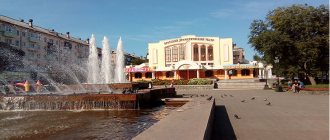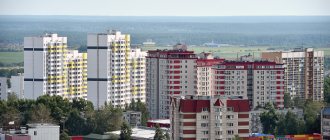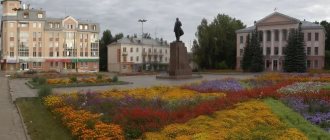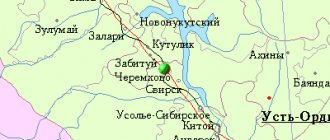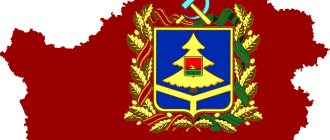Year founded: 1955
City Day is celebrated
on December 12
.
Hotel "Taiga" (Photo: S. Anisimov)
Bratsk
- a city in the Irkutsk region of Russia, located 490 km north of Irkutsk, in the center of the Angarsk Ridge, on the shore of the Bratsk Reservoir.
Historical reference
. A small fortress on the Angara River at the mouth of the Oka River was founded by Cossack explorers in 1631 and called it the Bratsk fortress. The origin of the name is explained by the Russian reinterpretation of the Buryat ethnonym into “brothers” - “brothers”.
After losing its military significance, the fort turned first into the village of Bratsko-Ostrozhnoe, then simply into Bratskoye and, finally, into Bratsk.
Bratsk Hydroelectric Power Station (Photo: www.bratsk-city.ru) In 1927, the Bratsk fort became the center of the Bratsk district of the Tulun district. In 1946, the Council of People's Commissars adopted the “Resolution on the organization of the Angarsk construction management.” In the fall of 1954, a resolution was adopted on the construction of the Bratsk hydroelectric power station. Thus began the construction of the Bratsk hydroelectric power station and the city of Bratsk. The site soon becomes an all-Union construction site.
In March 1957, the first closure of the Angara was completed, and in the summer of 1961 the filling of the Bratsk Reservoir began. Finally, on September 1, 1961, a historical event occurred - the birth of the Brotherly Sea. The village of Bratsk is flooded along with many other villages - in the Bratsk region alone, 119 settlements were resettled and went under water.
Near the drama theater (Photo: G. Taraskov)
The village of Bratsk itself was moved to a new location and, back in 1951, transformed into a workers’ village. In 1955, it was merged with a number of other villages and transformed into the city of Bratsk on December 12, 1955.
Today
Bratsk is one of the largest industrial centers of the Irkutsk region and Eastern Siberia. And although the city is located in harsh climatic conditions, its economic and geographical position is relatively favorable and is characterized by developed infrastructure.
Railway (Baikal-Amur Mainline), roads, power lines, an airport with international status, high resource and economic potential, electric power resources of the Bratsk Hydroelectric Power Station, unlimited water resources, shipping and timber rafting routes - Bratsk functions as an important support base for the development of the northern regions of Eastern Siberia and the Far East.
Night city (Photo: G. Taraskov)
The permanent population of Bratsk is more than 225 thousand people (2021). Mostly young people live here. The average age of city residents is 36 years, and children under 16 make up about 18%.
Not far from Bratsk, 60 km to the east, there is the Bratsk Seaside, a climatic resort area on the coast of the Bratsk Reservoir, where patients with diseases of the circulatory system and nervous system are treated. This is also facilitated by sodium sulfate-chloride water, found here in 1976.
Day of the city
dedicated to the day of its foundation and celebrated on December 12.
Bratsk
(Irkutsk region)
OKATO code:
25414
Founded:
1954
Urban settlement since:
1954
City since:
1955 City of regional subordination
Center:
Bratsk district
Urban districts, population as of 01/1/2021
| Padunsky | 51.3 | Pravoberezhny | 35.3 | Central | 138.4 |
| Telephone code (reference phone) | |
| 3953****** | 43-38-50 |
Deviation from Moscow time, hours:
5
Geographic latitude:
56°09′
Geographic longitude:
101°37′
Altitude above sea level, meters:
450 Sunrise and sunset times in the city of Bratsk
Historical facts of the city
- From 1630 to 1648, the Bratsk fort was built, which served to gather troops, had a defensive function, and was a place for the exchange of goods.
- The entire 17th century belonged to the Yenisei fort, gradually changing the name to the modern one. There is a confident development of trade routes and the economy.
- In 1917, Soviet power was established in the city.
- The most important point is the construction of the Bratsk hydroelectric power station in 1955, which became the point of uniting nearby settlements under one name, blocking the Angara, and creating a reservoir.
Map
| Bratsk: maps |
Bratsk: photo from space (Google Maps) Bratsk: photo from space (Microsoft Virtual Earth)
| Bratsk Nearest cities. Distances in km. on the map (in brackets along roads) + direction. Using the hyperlink in the distance , you can get the route (information courtesy of the AutoTransInfo website) | |||
| 1 | Vikhorevka | 28 (30) | Z |
| 2 | Chunsky | 122 (626) | Z |
| 3 | Lesogorsk | 129 () | Z |
| 4 | Zheleznogorsk-Ilimsky | 161 (236) | IN |
| 5 | New Igirma | 178 (286) | NE |
| 6 | Tulun | 189 (225) | YU |
| 7 | Alzamay | 196 (438) | Z |
| 8 | Kuitun | 203 (295) | YU |
| 9 | Railway | 205 () | WITH |
| 10 | Ust-Ilimsk | 210 (242) | WITH |
| 11 | Nizhneudinsk | 215 (348) | SW |
| 12 | Taishet | 224 (505) | Z |
| 13 | Sayansk | 229 (377) | YU |
| 14 | Biryusinsk | 237 (514) | Z |
a brief description of
Located in the central part of the Angara Ridge, on the shore of the Bratsk Reservoir, 490 km north of Irkutsk. Port. Railway station.
60 km east of Bratsk is the Bratsk Seaside, a climatic resort area on the coast of the Bratsk Reservoir. Sodium sulfate-chloride water was discovered in 1976. Patients with diseases of the circulatory system and nervous system are treated.
Territory (sq. km): 428
Information about the city of Bratsk on the Russian Wikipedia site
Historical sketch
It arose in connection with the construction of the Bratsk hydroelectric power station north of the village of Bratsk (founded as a fort in 1631 at the mouth of the Oka River), flooded by the waters of the Bratsk Reservoir.
Since 1927, the village of Bratskoye (Bratsky fort) has been the center of the Bratsky district of the Tulun district. In 1946, the Council of People's Commissars of the SSR adopted the “Resolution on the organization of management of Angarsk construction” (Angarstroy). On September 23, 1954, a resolution was adopted on the construction of the Bratsk hydroelectric power station. On July 15, 1955, the construction of the Bratsk hydroelectric power station and the city of Bratsk was declared an all-Union construction project. On March 30, 1957, the first closure of the Angara was completed (the river was blocked for more than 9 hours). On July 26, 1961, the filling of the Bratsk Reservoir began; September 1, 1961 is considered the date of birth of the Bratsk Sea.
In the Bratsk district alone, 119 settlements were earmarked for transfer, incl. working village of Zayarsk (6.4 thousand inhabitants, 1959). On August 29, 1961, the evacuation of residents of old Bratsk was completed. In 1959, there was the city of Bratsk (51.5 thousand inhabitants, 1959) and the working settlement of Bratsk (15.8 thousand inhabitants, 1959).
The name of the Bratsk fort is from the ethnonym Buryats, reinterpreted by the Russians into brothers - “brothers”. With the loss of military significance, the fort turns into the village of Bratsko-Ostrozhnoe, sometimes simply Bratskoe, later Bratsk.
In connection with the construction of the Bratsk Reservoir, the village of Bratsk was moved to a new location and in 1951 transformed into a workers’ settlement. In 1955 it was merged with a number of other villages and reorganized into the city of Bratsk on December 12, 1955.
In 1973, the Padunsky urban district was formed, it included the villages of Padun, Energetik, Gidrostroitel, Osinovka and the Bratsk Sea.
In 1980, the Central City District was formed; previously it was listed as “part of the city without districts.”
In 1999, the city included the working settlements of Osinovka (PGT since 1960; 10.9 thousand inhabitants, 1970; 14.4 thousand inhabitants, 1979; 15.9 thousand inhabitants, 1989), Porozhsky (PGT since 1960). , 6.4 thousand inhabitants, 1970; 5.8 thousand inhabitants, 1979; 5.3 thousand inhabitants, 1989), Chekanovsky (PGT since 1960, 12.5 thousand inhabitants, 1970; 10.1 thousand inhabitants, 1979; 7.8 thousand people, 1989).
Municipal indicators
| Index | 1999 | 2001 | 2003 | 2005 |
| Demography | ||||
| Number of births, per 1000 population | 8.7 | 9.7 | 11.3 | 10.6 |
| Number of deaths, per 1000 population | 13.1 | 12.7 | 16 | 15 |
| Natural increase (decrease), per 1000 population | -4.4 | -3 | -4.7 | -4.4 |
| Standard of living of the population and social sphere | ||||
| Average monthly nominal accrued wages, rub. | 2801 | 5120 | 8019 | 11195 |
| Average housing area per inhabitant (at the end of the year), sq.m. | 18.1 | 18.5 | 20.1 | 21 |
| Number of preschool institutions, pcs. | 63 | 60 | 58 | 57 |
| Number of children in preschool institutions, thousand people | 9.6 | 9.6 | 9.7 | 10.4 |
| Enrollment of children in preschool educational institutions (at the end of the year), as a percentage of the number of children of the corresponding age, % | 71 | 66.8 | ||
| Number of daytime educational institutions (at the beginning of the school year), pcs. | 47 | 46 | 44 | 44 |
| Number of students in daytime educational institutions, thousand people | 39.9 | 36.5 | 32.3 | 27.9 |
| Number of doctors, people. | 951 | 904 | 884 | 759 |
| Number of nursing staff, people. | 3017 | 2770 | 2802 | 2568 |
| Number of hospital institutions, pcs. | 14 | 13 | 13 | 10 |
| Number of hospital beds, thousand units | 2.6 | 2.5 | 2.3 | 2.4 |
| Number of medical outpatient clinics, pcs. | 19 | 17 | 17 | 13 |
| Capacity of medical outpatient clinics, visits per shift, thousand units. | 4.2 | 4.5 | 4.1 | 4.4 |
| Number of registered crimes, pcs. | 9800 | 8453 | 8533 | 10829 |
| Persons who committed crimes were identified, persons. | 4340 | 3790 | 3231 | 3037 |
| Economy, industry | ||||
| Number of enterprises and organizations (at the end of the year), pcs. | 4134 | 4419 | 4909 | 10792 |
| Number of operating enterprises by type of activity: mining (at the end of the year), pcs. | 4 | |||
| Number of operating enterprises by type of activity: manufacturing (at the end of the year), pcs. | 139 | |||
| Number of operating enterprises by type of activity production and distribution of electricity, gas and water (at the end of the year), pcs. | 25 | |||
| Volume of shipped goods of own production by type of mining (in actual prices), million rubles. | 12.6 | |||
| Volume of shipped goods of own production by type of manufacturing (in actual prices), million rubles. | 38684.4 | |||
| Volume of shipped goods of own production by type of production and distribution of electricity, gas and water (in actual current prices), million rubles. | 1288.9 | |||
| Construction | ||||
| Volume of work performed by type of activity “Construction” (until 2004 - volume of work performed under construction contracts), million rubles. | 754 | 924.4 | 749 | 1743.9 |
| Commissioning of residential buildings, thousand sq.m. of total area | 12.1 | 7.7 | 16.3 | 18.8 |
| Commissioning of residential buildings, apartments | 187 | 42 | 206 | 191 |
| Commissioning of preschool institutions, places | 0 | 0 | 0 | 0 |
| Commissioning of educational institutions, places | 0 | 0 | 0 | 0 |
| Commissioning of hospital facilities, beds | 0 | 0 | 90 | 7 |
| Commissioning of outpatient clinics, visits per shift | 150 | 0 | 100 | 100 |
| Transport | ||||
| Number of bus routes (in intracity traffic), pcs. | 25 | 22 | 7 | 25 |
| Number of tram routes, pcs. | 0 | 0 | ||
| Number of trolleybus routes, pcs. | 5 | 5 | ||
| Length of operational trolleybus lines (at the end of the year), km | 22.2 | 22.2 | ||
| Number of passengers transported by buses per year (in intracity traffic), million people. | 47.6 | 19.3 | 16 | 15.1 |
| Number of passengers transported by trams per year, million people. | 0 | |||
| Number of passengers transported by trolleybuses per year, million people. | 33.2 | 32.7 | 15.4 | |
| Connection | ||||
| Number of residential telephone sets of the city public telephone network, thousand units. | 44.4 | 49 | 64.5 | 63.8 |
| Number of payphones of the city telephone network (including universal ones), pcs. | 283 | 384 | ||
| Trade and services to the population | ||||
| Retail trade turnover (in actual prices), million rubles. | 3284.7 | 6807 | 8744.7 | 12867.5 |
| Retail trade turnover (in actual prices), per capita, rub. | 11815 | 24592 | 33829 | 50321 |
| Index of physical volume of retail trade turnover, % compared to the previous year | 102.8 | 121.4 | ||
| Public catering turnover (in actual prices), million rubles. | 182.7 | 159.9 | 293.3 | 472 |
| Index of physical volume of public catering turnover, % compared to the previous year | 117.7 | 110.9 | ||
| Number of stores, pavilions (at the end of the year), pcs. | 61 | 80 | ||
| Sales area of shops, pavilions (at the end of the year), sq.m. | 3964 | 5206.7 | ||
| Volume of paid services to the population (in actual prices), million rubles. | 923 | 1461.8 | 3122.7 | 4276 |
| Volume of paid services to the population (in actual prices), per capita, rub. | 3320 | 5289 | 12080 | 16721.6 |
| Volume of household services to the population (in actual prices), million rubles. | 115.7 | 189.2 | 271.1 | 431.4 |
| Volume of household services to the population (in actual prices), per capita, rub. | 416.1 | 684 | 1049 | 1687 |
| Investments | ||||
| Investments in fixed assets (in actual prices), million rubles. | 911 | 1020.4 | 1513.3 | 1695.6 |
| Share of investments in fixed assets financed from budgetary funds in the total volume of investments, % | 8.8 | 11.3 | 8.1 | 7.6 |
Data sources:
- Regions of Russia. Main characteristics of the constituent entities of the Russian Federation: statistical collection. Goskomstat of Russia. - M:, 2003.
- Regions of Russia. Volume 1. Statistical collection. Goskomstat of Russia. - M:, 2001. p. 505
- Regions of Russia. Basic socio-economic indicators of cities. Statistical collection. Rosstat. - M:, 2005. p. 319
- Transport in Russia: Statistical collection. Goskomstat. - M:, 2003. pp. 112, 122
- Transport in Russia: Statistical collection. Rosstat. - M:, 2005. pp. 119, 129
- Regions of Russia. Basic socio-economic indicators of cities. 2006. Statistical collection. Rosstat. - M:, 2006. p. 315
Economy
Bratsk timber industry complex. Factories: aluminum, Sibteplomash. Complex of Bratskgesstroy enterprises.
Food industry enterprises (meat processing plant, dairy plant, poultry farm, brewery, etc.).
In the Bratsk region, grain and fodder crops, potatoes, and vegetables are grown. Dairy farming.
Main enterprises
NON-FERROUS METALLURGY
OJSC "Bratsk Aluminum Plant"
665716, Irkutsk region, Bratsk,
Offers:
primary aluminum, aluminum wire rod, aluminum ingots
FORESTRY, WOOD PROCESSING AND PULP AND PAPER INDUSTRY
OJSC "Bratsk Timber Industry Complex"
665718, Irkutsk region, Bratsk, st.
Mira, 1 Offers:
cellulose, cardboard, plywood, fiberboard
PULP AND PAPER INDUSTRY
OJSC "Pulp and Cardboard Mill"
665718, Irkutsk region, Bratsk, st.
Mira, 1 Offers:
paint and varnish materials, drying oil, rosin
Culture, science, education
Research Institute of Pulp and Cardboard.
Industrial Institute.
Theatres: drama, puppet.
Museums: ethnographic open air - “Angarsk Village”, historical, local history and political exile.
Universities of the city
Bratsk State University
665709, Irkutsk region, Bratsk, st. Makarenko, 40 WWW: https://www.brstu.ru/
Branch of the Baikal State University of Economics and Law in Bratsk
665719, Irkutsk region, Bratsk, st. Karl Marx, 14 WWW: https://www.isea.bratsk.ru/
Branch of Irkutsk State University in Bratsk
665729, Irkutsk region, Bratsk, st. Lenina, 34
Branch of the Irkutsk State Transport University in Bratsk
665776, Irkutsk region, Bratsk, Zheleznodorozhnaya st., 4
Museums, galleries, exhibition halls
Architectural and Ethnographic Museum "Angarsk Village" 665717, Irkutsk region, Bratsk, st.
Komsomolskaya, 38 Telephone(s): (3953) 41-2834 Bratsk City United Museum of the History of the Development of the Angara 665717, Irkutsk Region, Bratsk, st. Komsomolskaya, 38 Phone(s): (3953) 41-2834
Museum of the History of Bratskgesstroy and the city of Bratsk 665702, Irkutsk region, Bratsk, st. Hydrostroiteley, 54 Phone(s): (3953) 35-9466
Museum of the History of Political Exile 665717, Irkutsk region, Bratsk, st. Parkovaya, 3 Phone(s): (3953) 41-4960
Art exhibition hall 665724, Irkutsk region, Bratsk, st. Komsomolskaya, 77 Phone(s): (3953) 42-0322
Architecture, sights
The city was formed from separate villages and now consists of several districts, tens of kilometers apart from each other. According to the master plan of 1958-61, industrial, residential and recreational zones were allocated, the House of Soviets, a cinema and other buildings were built. Residential microdistricts with panel and brick buildings of 4-9 floors, with schools and childcare centers are grouped around preserved areas of the taiga.
Near the hydroelectric power station is the village of Energetik with 4 microdistricts.
| Population by year (thousands of inhabitants) | |||||||
| 1959 | 51.5 | 1986 | 245 | 2005 | 256.6 | 2014 | 238.8 |
| 1962 | 82 | 1989 | 255.7 | 2006 | 254.9 | 2015 | 236.3 |
| 1967 | 122 | 1992 | 259.3 | 2007 | 253.2 | 2016 | 234.1 |
| 1970 | 155.4 | 1996 | 256 | 2008 | 252.0 | 2017 | 231.6 |
| 1973 | 175 | 1998 | 253.6 | 2010 | 249.7 | 2018 | 229.3 |
| 1976 | 195 | 2000 | 277.6 | 2011 | 246.3 | 2019 | 227.5 |
| 1979 | 213.7 | 2001 | 277.1 | 2012 | 243.9 | 2020 | 226.3 |
| 1982 | 227 | 2003 | 259.3 | 2013 | 241.3 | 2021 | 225.0 |
Angarsk - located on the main river of the region
Angarsk is the third largest and second largest settlement in the Irkutsk region: 294 km² and 226,374 inhabitants. It owes its appearance to the active development of industry in Siberia, and specifically to the construction of a plant for the production of liquid fuel. Equipment for it was received as reparations after the victory in the Great Patriotic War. These two facts gave rise to the unofficial but telling names of the settlement: “city of petrochemists” or “born of Victory.”
From the beginning of the construction of the first temporary houses for workers who came to the construction site in 1945 and until 1959, the number of residents increased from zero to 134,000: in a short time, about 70,000 m² of housing was built for them. Today's Angarsk is one of the most modern and comfortable settlements in Transbaikalia. It has been repeatedly recognized as the most comfortable and clean at all-Russian competitions.
As at the beginning of development, industry is the basis of the economy: it accounts for about 13% of the total regional volume. Angarsk is one of the largest industrial zones in Asia, stretching along the Angarsk coast for a record 30 km. If previously the city-forming enterprise was the petrochemical plant, which ensured the emergence of the city, today the budget is formed thanks to hundreds of other enterprises. More than 6,000 companies in various fields of activity are registered here, including 4 large industrial complexes.
Popular message topics
- Email Email
is information stored on a computer that is transferred between two users via telecommunications. Simply put, email is a message that can contain text, files, - Tea
Tea (translated from Chinese “cha”, from the Beijing and Guangdian dialects - “te”) is a drink obtained by boiling, brewing or infusing tea tree leaves. The tea tree leaf undergoes special treatment before use. - City of Korolev
Everyone knows the great very first cosmonaut from the USSR, Yuri Alekseevich Gagarin, who on the Vostok-1 spacecraft made the world's first flight into such an unknown space at that time as space. Indeed, this man's name was
SOLNECHNAYA STREET, HOLLYWOOD CINEMA, SOLNECHNY POOL, PARK, PALACE OF CHILDREN'S CREATIVITY
Solnechnaya Street, one of the most pleasant streets, turns off perpendicular to Naimushina Street. It is short, but very rich in local attractions.
Its main attraction is the Hollywood cinema. Previously, you wouldn’t surprise anyone with cinemas; there were more than one in every remote area and village. Now, in the age of computers and home theaters, there are only two left in all of Bratsk. Nevertheless, sometimes I want to watch some bright film from the big screen, and even with special ones. effects.
There are two halls where you can watch regular films or 3D. It’s a pity that very few good films, especially Russian ones, are shown. More and more American thrillers and stupid comedies. In the cinema lobby there are two cafes where you can eat something delicious. The box office telephone number is 37-61-10, the answering machine is 35-53-50.
On the square in front of the cinema on the left there is a Sports Complex with a swimming pool “Solnechny” (Solnechnaya Street, building 4, telephone). In the summer there are only hand-to-hand combat sections and a circus studio.
A 25 m long swimming pool with 6 lanes will open in mid-September. There is a gymnasium and a universal gym, two saunas. Prices for the pool for a single visit from 8 a.m. to 6 p.m. are 100 rubles, from 6 p.m. to 10 p.m. are 150 rubles. You can save a little by purchasing a subscription for 8 visits or 12.
In the center of the Square in the park there is a monument to the hero of the Soviet Union Stepan Borisovich Pogodaev. Pogodaev lived in the village of Sedanovo and was the chairman of the collective farm from 1931. In 1941 he went to the front and died during the assault on Sapun Mountain near Sevastopol on May 9, 1944, covering a machine gun embrasure. Thus, he saved the lives of many soldiers of his unit who were dying under machine-gun fire, and helped complete the combat mission.
Every year, on the day of Victory Day celebrations, a festive procession ends and a rally takes place near the monument to Pogodaev S.B., and a guard of honor is lined up at the monument.
On the other side of the square is the Palace of Children's and Youth Creativity named after E.A. Yevtushenko, former Palace of Pioneers. There, children study in various clubs, exhibitions of local artists and other events take place.
There is a park right behind the cinema. This is an abandoned forest area with paths along which are nice to walk. It is a pity that the park is being cut down for various commercial purposes.
For children, a part of the park is fenced off for attractions; there are carousels, trampolines, and a shooting gallery. On the hill, as a reminder of the past war, there are two tanks and a cannon. On May 9, soldiers' porridge is delivered there and distributed to everyone who wants to try it.
On Bratsk City Day on December 12, 2022, the main Christmas tree will be opened
On December 12, City Day, the grand opening of the main New Year tree of Bratsk will take place on the square in front of the theater and concert hall.
The celebration will begin at 19:30. This evening the townspeople will see fireworks.
At 19.30 a small concert program will begin. And at approximately 19.50 we open the Christmas tree and set off the fireworks. All services are ready for the event. “Preliminarily, on Monday we will check the connection of the New Year tree,” said Chairman of the Central District Management Committee Yuri Rykhlov.
Three ice figures will be installed near the festive tree - Father Frost, Snow Maiden and the symbol of the New Year.
And this year the main ice town will be located in the Metallurgists Park, and a large New Year tree will also be installed there, the city administration reported.
The main New Year tree of Bratsk with dynamic lighting (3D system) is 23 meters high, including the podium. This spruce can withstand frosts down to -50 degrees. There are 64 garlands on it. And the 3D system allows you to program any light compositions.
Irkutsk is the capital of a region with a rich history
Irkutsk is only in third position in terms of territory size, but in terms of the number of residents it is the undisputed leader with 623,869. The population of the agglomeration is even larger: according to information for 2018, it exceeds 1.1 million.
Since its foundation in the second half of the 17th century, it has played an important role in the life of the region. The merchant city had strong trade relations with China, the central and eastern regions of the country, and later repeatedly acted as a zone of exile. It is included among the historical settlements of Russia, and also boasts an abundance of attractions, mostly concentrated in the old center. Irkutsk is a student city, a major transport hub of the region and an important economic center, where many enterprises of all-Russian importance operate, including the largest Russian company in the energy sector, Irkutskenergo.
FIFTH AND SEVENTH MICRORORISTS OF ENERGY.
These are relatively new neighborhoods. Among the attractions we can note: MFC “My Documents” at st. Yubileinaya 15. Opening hours from 9 to 19, on Saturday from 10 to 14. Here you can get a lot of government. services and documents for individuals and legal entities.
Large, by Energy standards, Inva Shopping Center on the street. Gindin 4. This is a building in which various departmental stores are located, for example, such as DNS, and grocery stores, and cafes. On the street there are shopping arcades where they sell various Chinese junk, imported fruits, and vegetables from their gardens.
